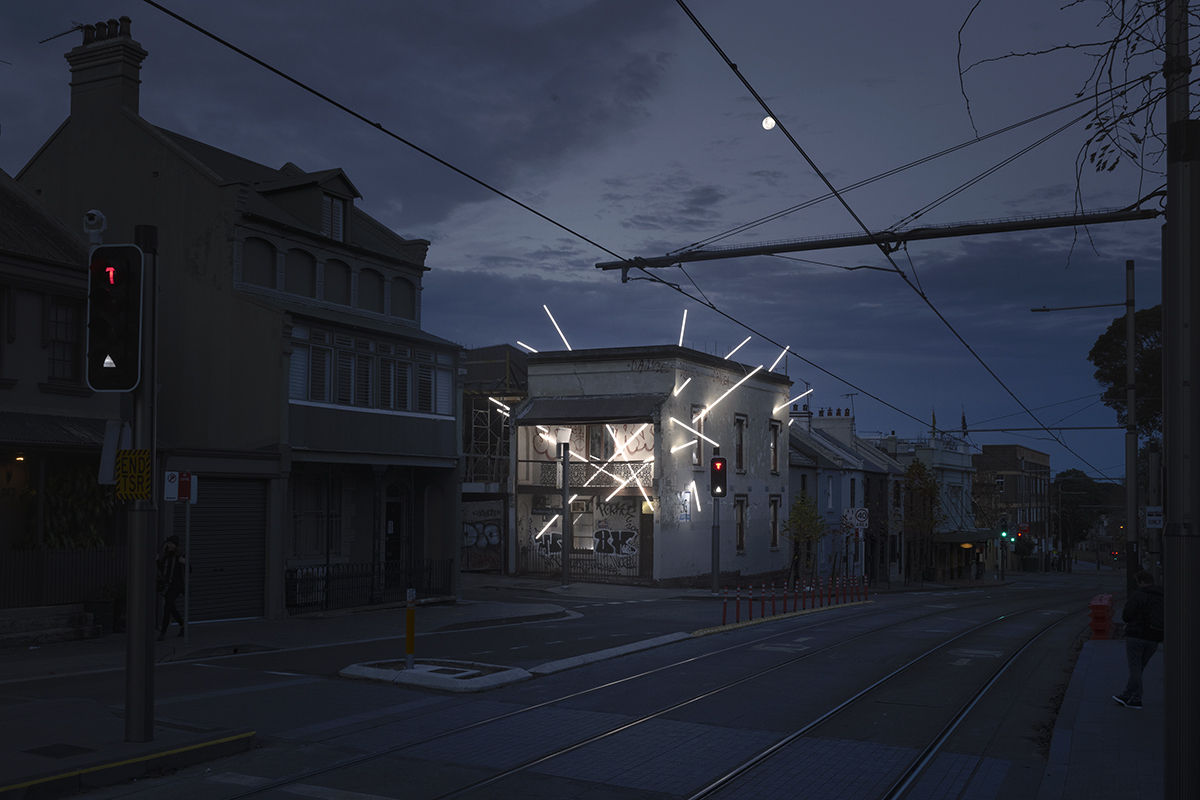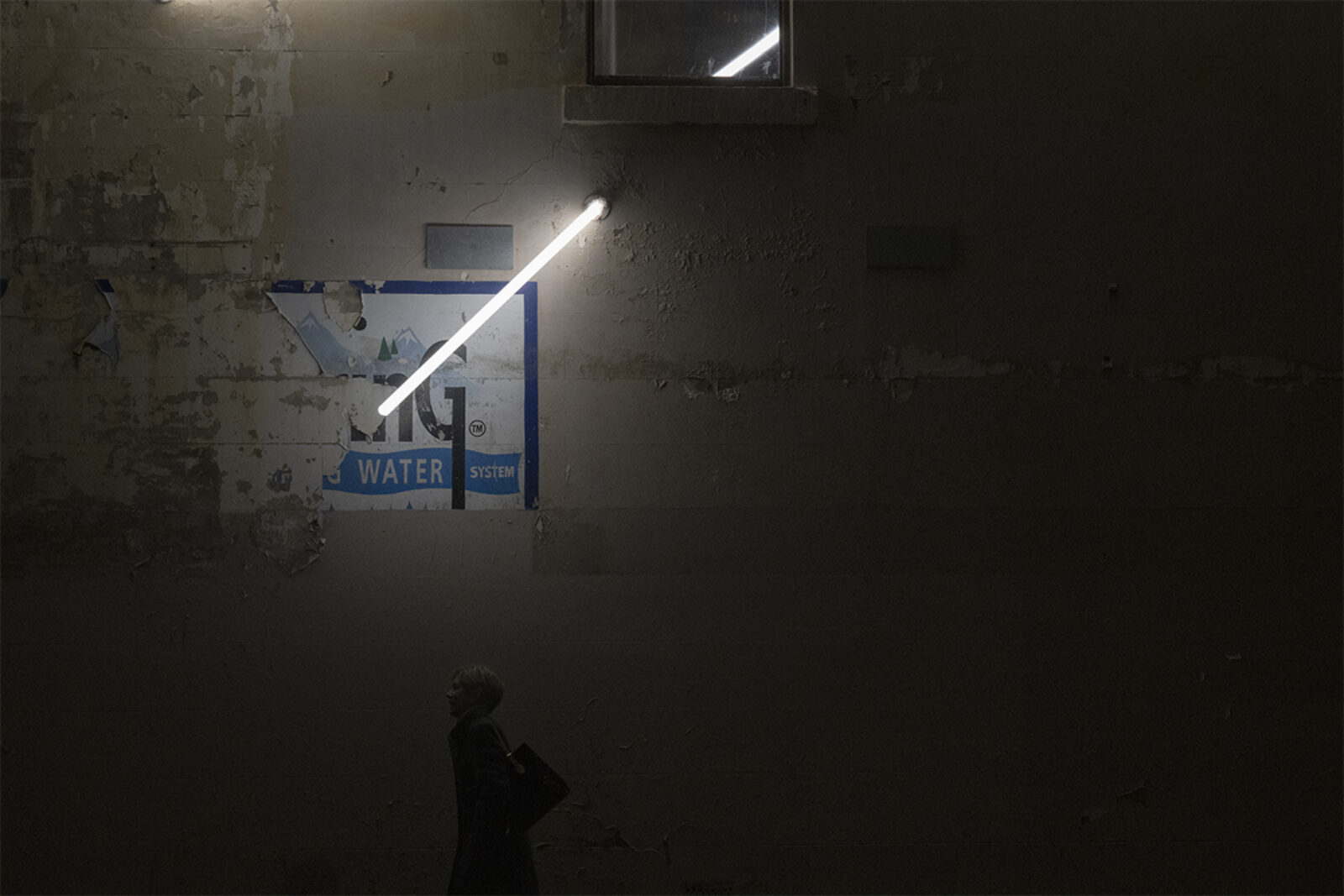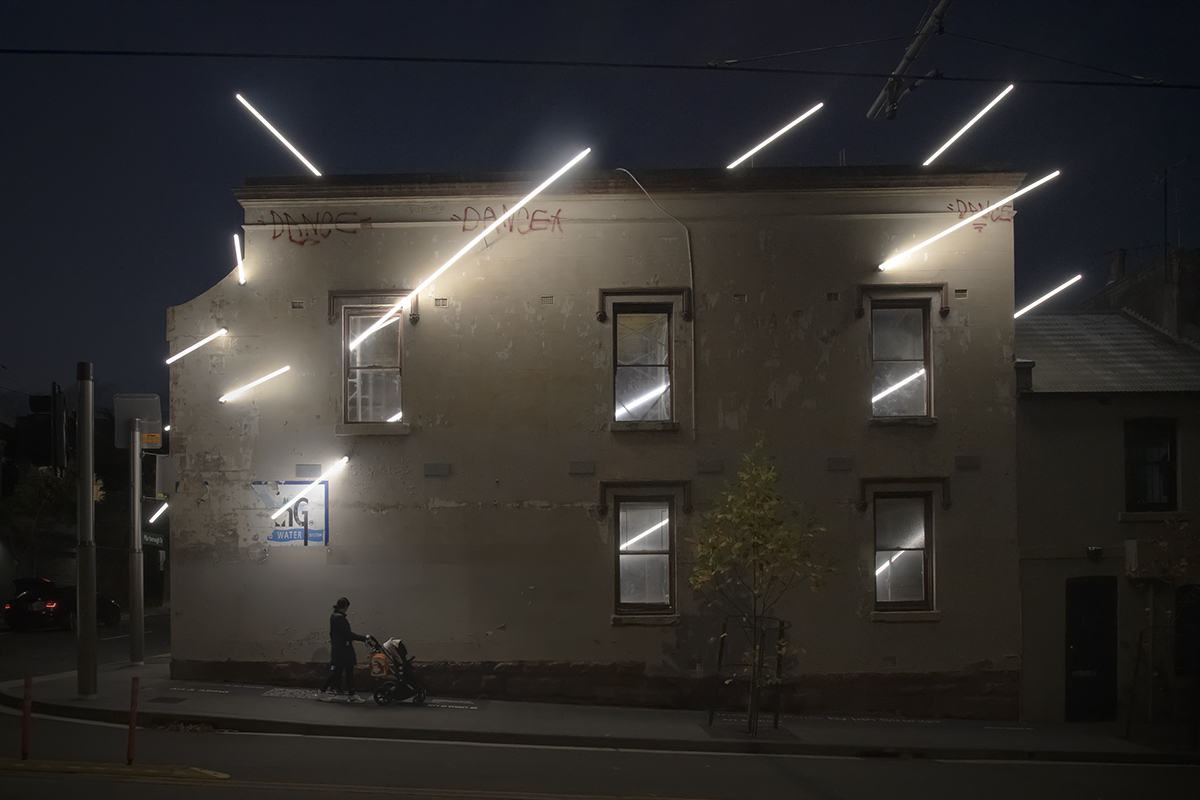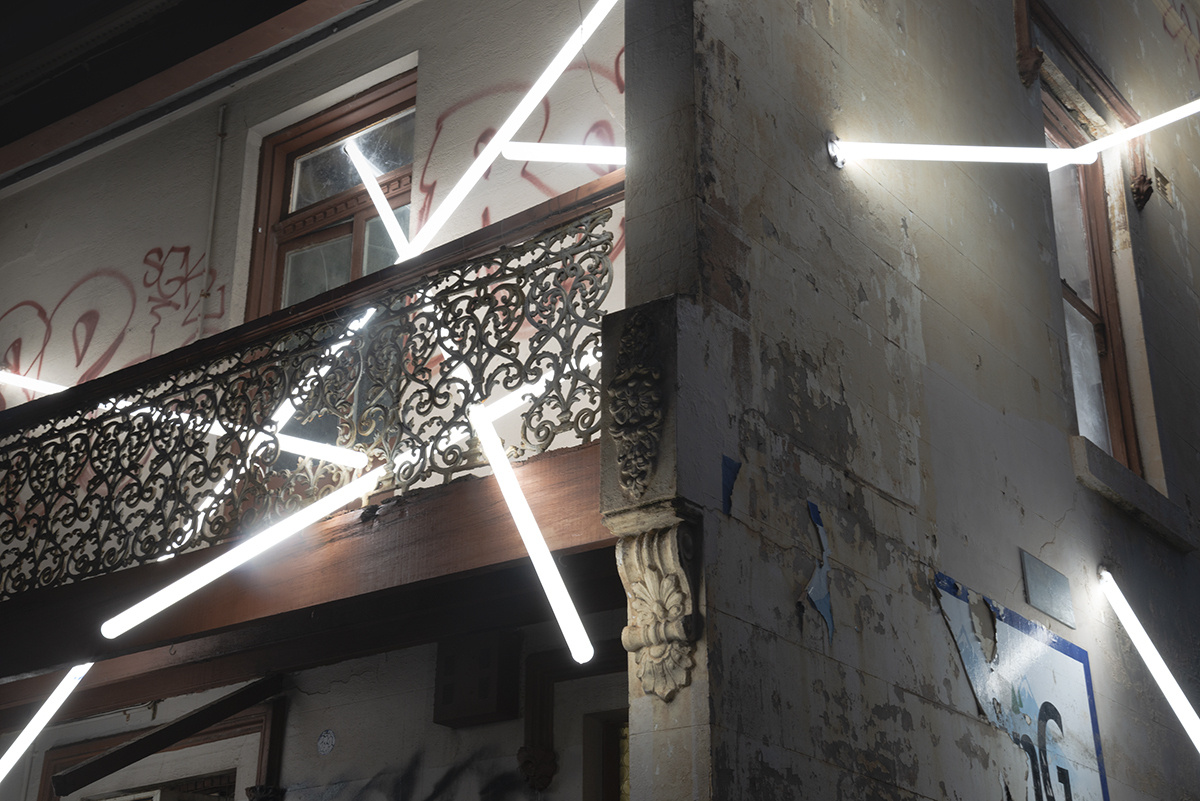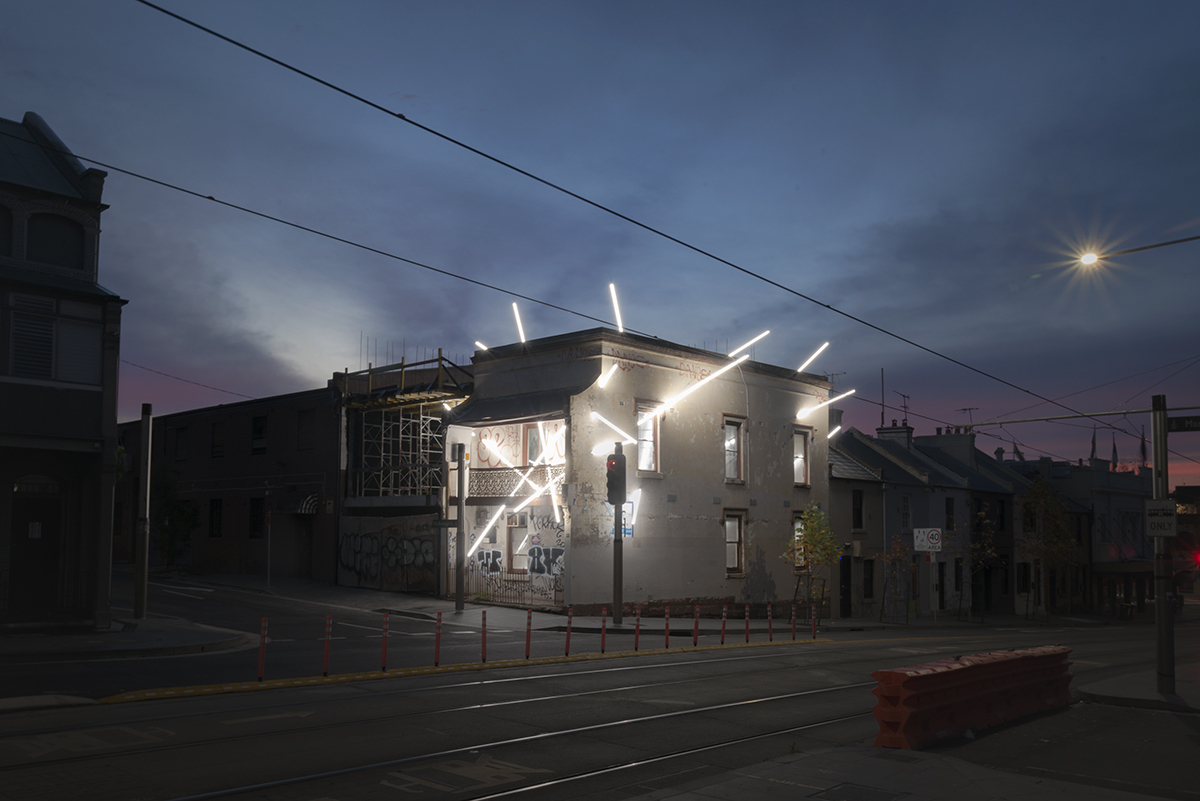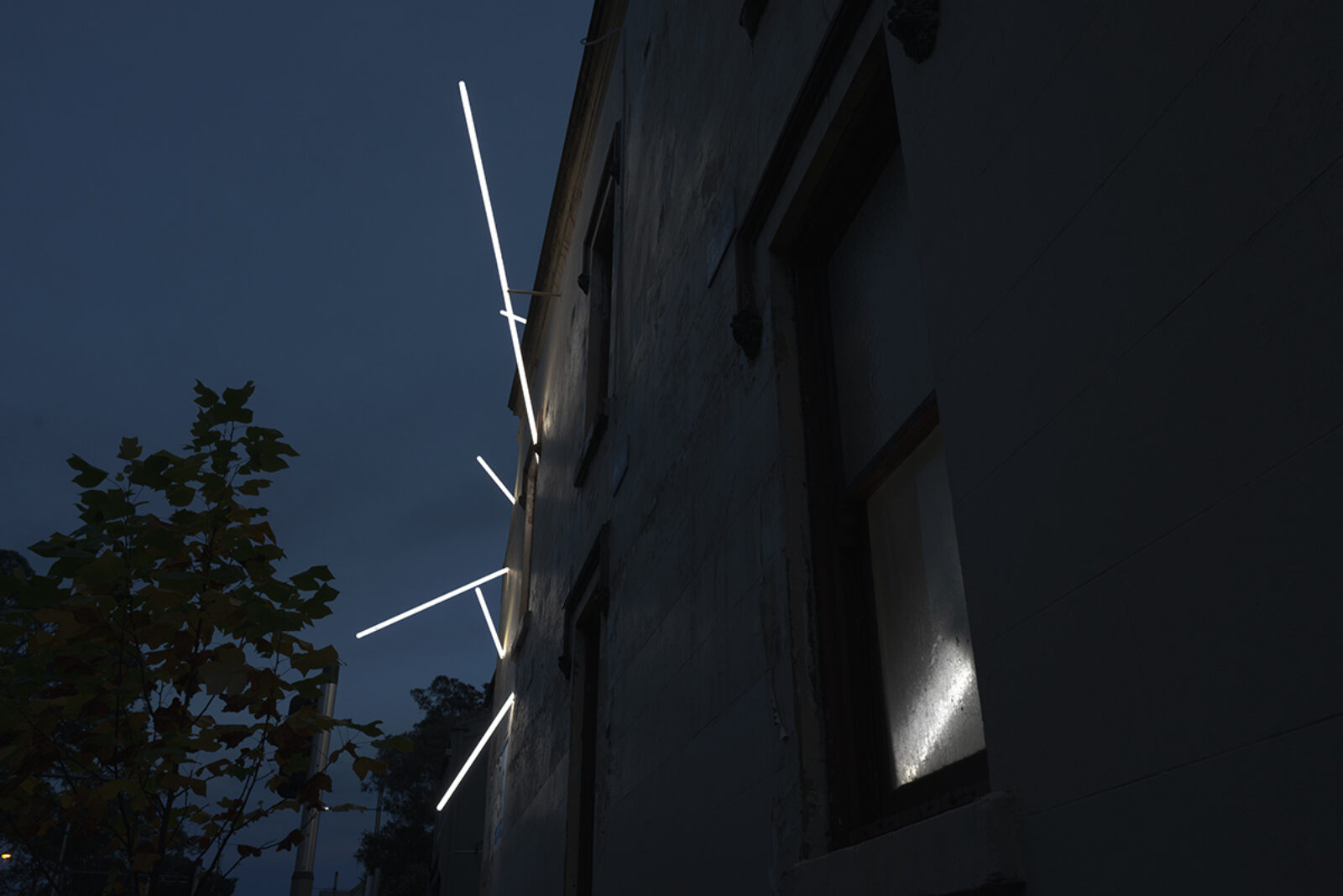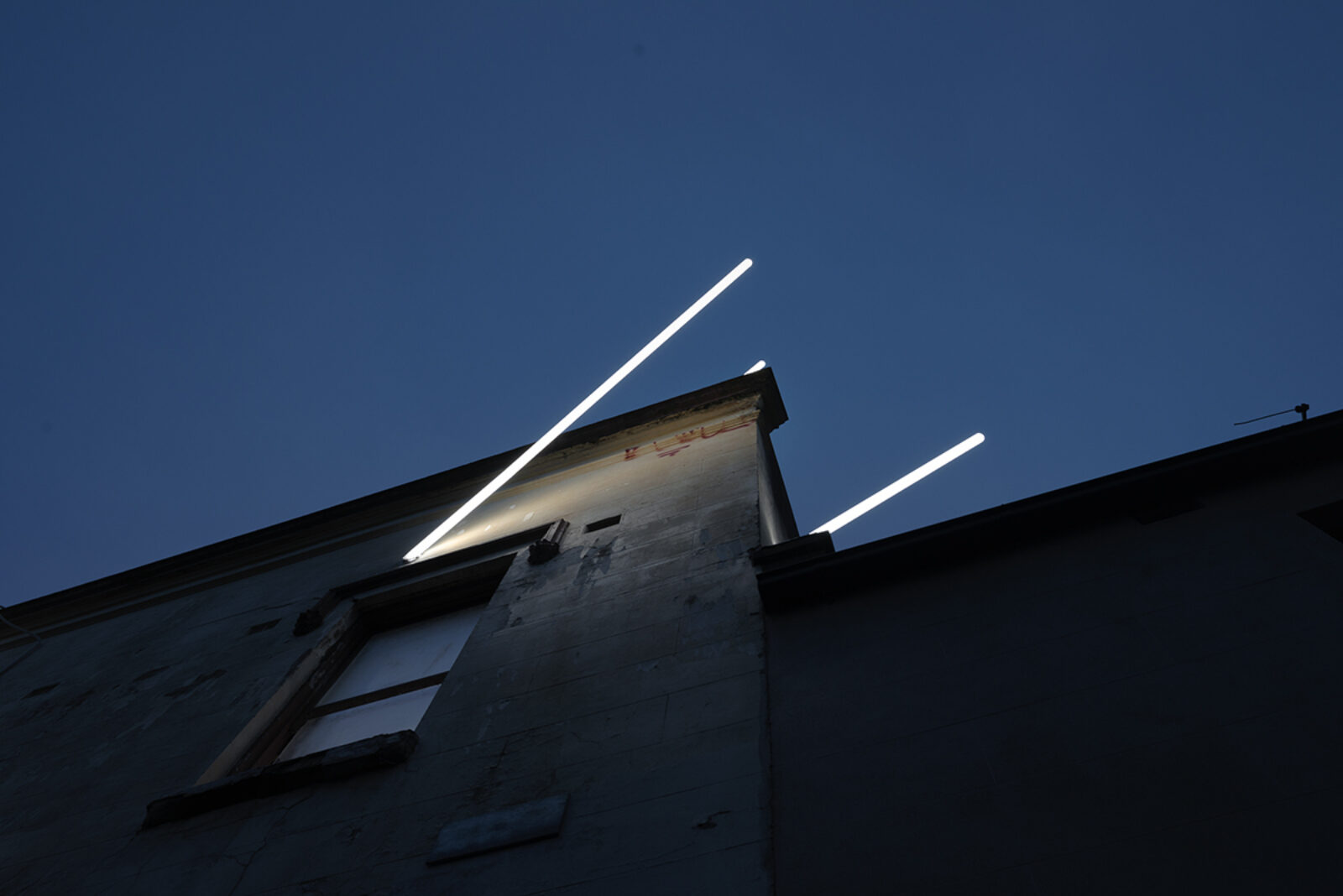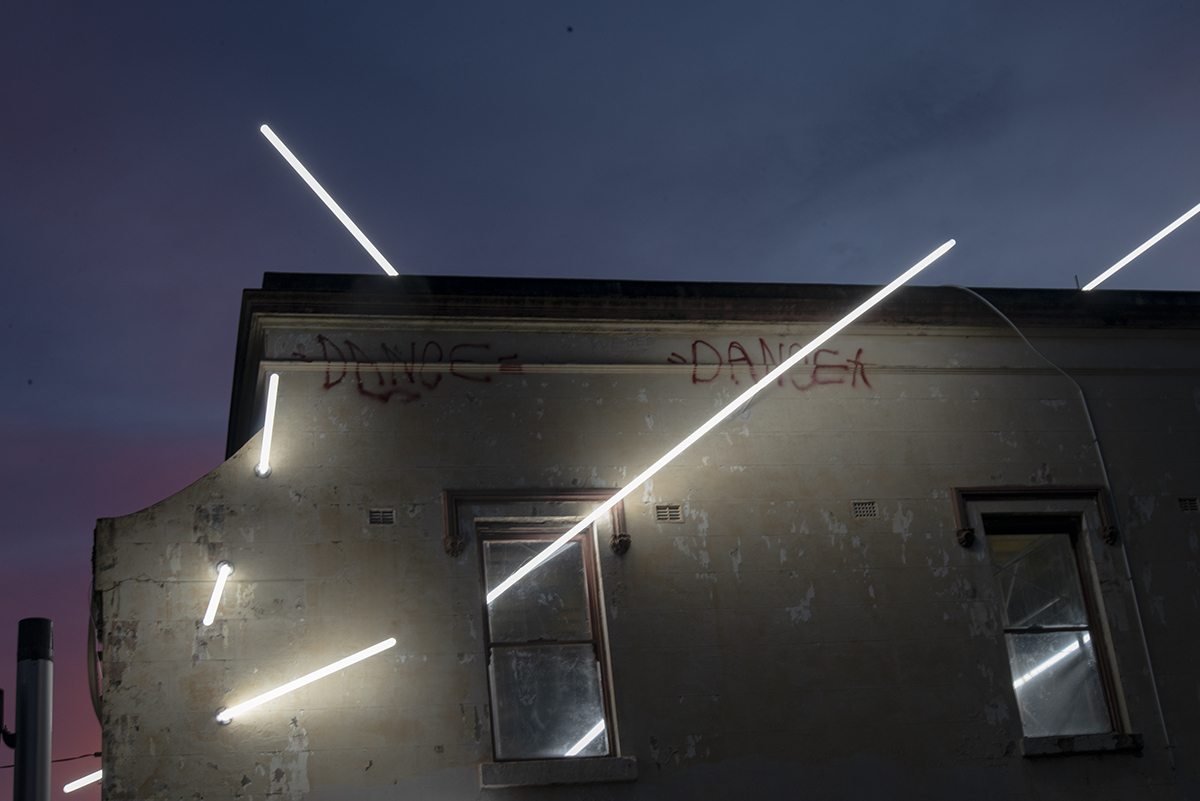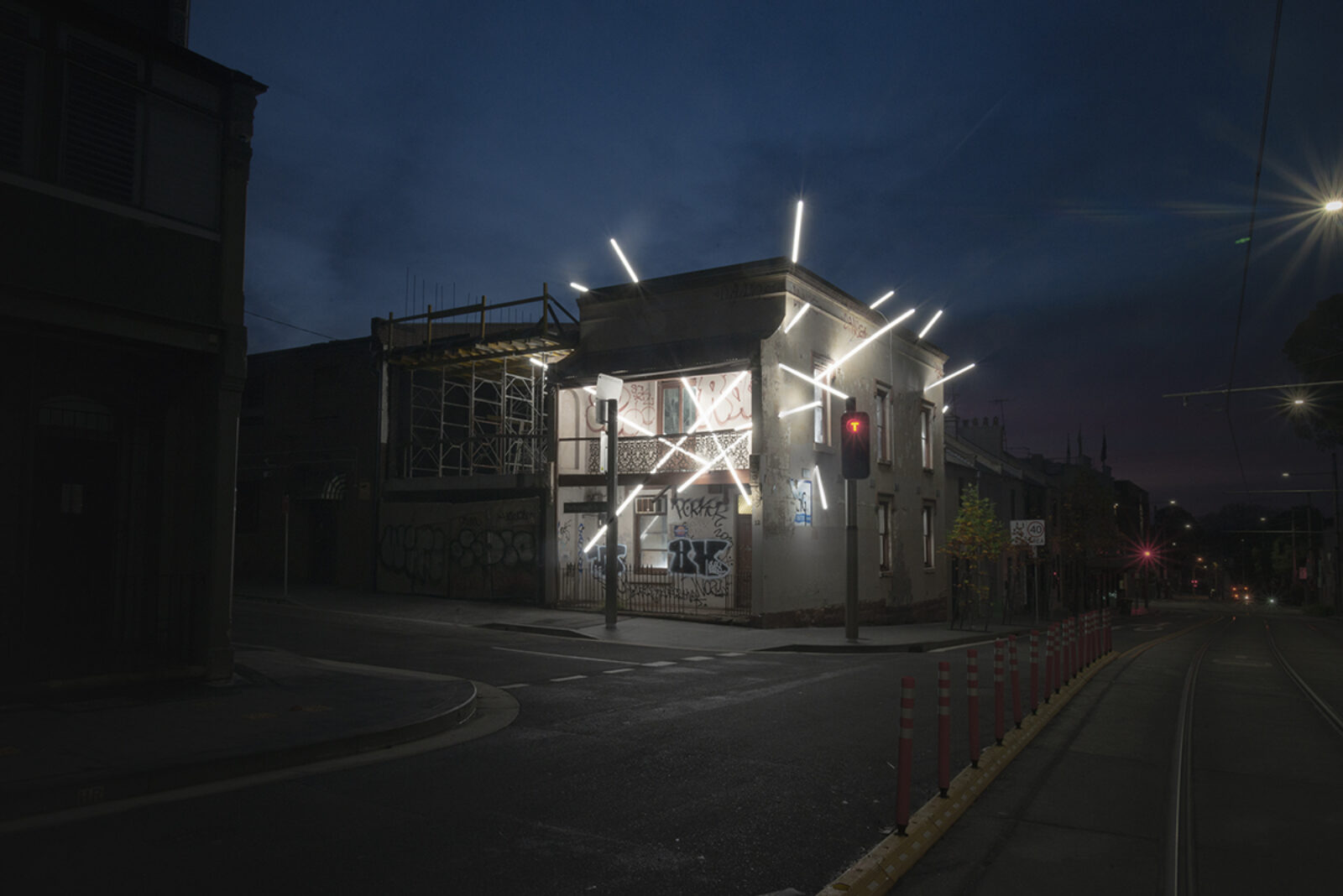LIGHT INTERSECTIONS II, 2021
Site-specific light installation
LIGHT INTERSECTIONS II is a site-specific public light installation commissioned by the City of Sydney as a part of their 2021 Art and About public art program.
This work forms the second iteration of Strange’s ongoing LIGHT INTERSECTIONS series, which explores manifestations of the hand-drawn line on the landscape and the built environment. The work interrogates a terraced suburban home in Surry Hills, Sydney. Here, light beams puncture the walls, ceiling, and windows across two planes, the lines of light suggesting large-scale hand-drawn lines in real space, creating an abstracted two-point perspective that punctures the building’s exterior and interior walls.
The work was on view in June and July 2021 for Art and About, and was created in collaboration with OFFICE, and Scoundrel Projects.
Sculpture & Installation
Writing
ESSAY: 'Threads of Vision'
by Rory Hyde
Originally published August, 2021
ESSAY: 'Threads of Vision'
by Rory Hyde
Originally published August, 2021
Threads of Vision
by Rory Hyde
[PDF]
At the time of the invention of perspective, it was still undecided how vision worked. One prominent theory suggested that invisible filaments projected out of the eye, latching onto objects, drawing in the mind what we perceive. The Renaissance polymath Leon Battista Alberti wrote in 1435, “Let one, without doubt, then, conveniently imagine the rays as certain extremely fine threads, connected as straight as they can be in a single extremity as in a bundle and accepted in the same place and at the same moment inside the eye, where the sense of sight resides.” [1] An etching by Abraham Bosse from 1648 shows three men in princely garb – ruffles, boots, hat, sword – appearing to cast shapes on the ground from different vantage points. Stray ‘threads’ of vision, squiggle out of their eyes, randomly, unable to find objects to affix to. This ‘Emission Theory’ of vision held for over 1,000 years, from the Ancient Greeks to Issac Newton, where lines of perspective were thought to be made physical, a network of taut vectors with which to describe the world.
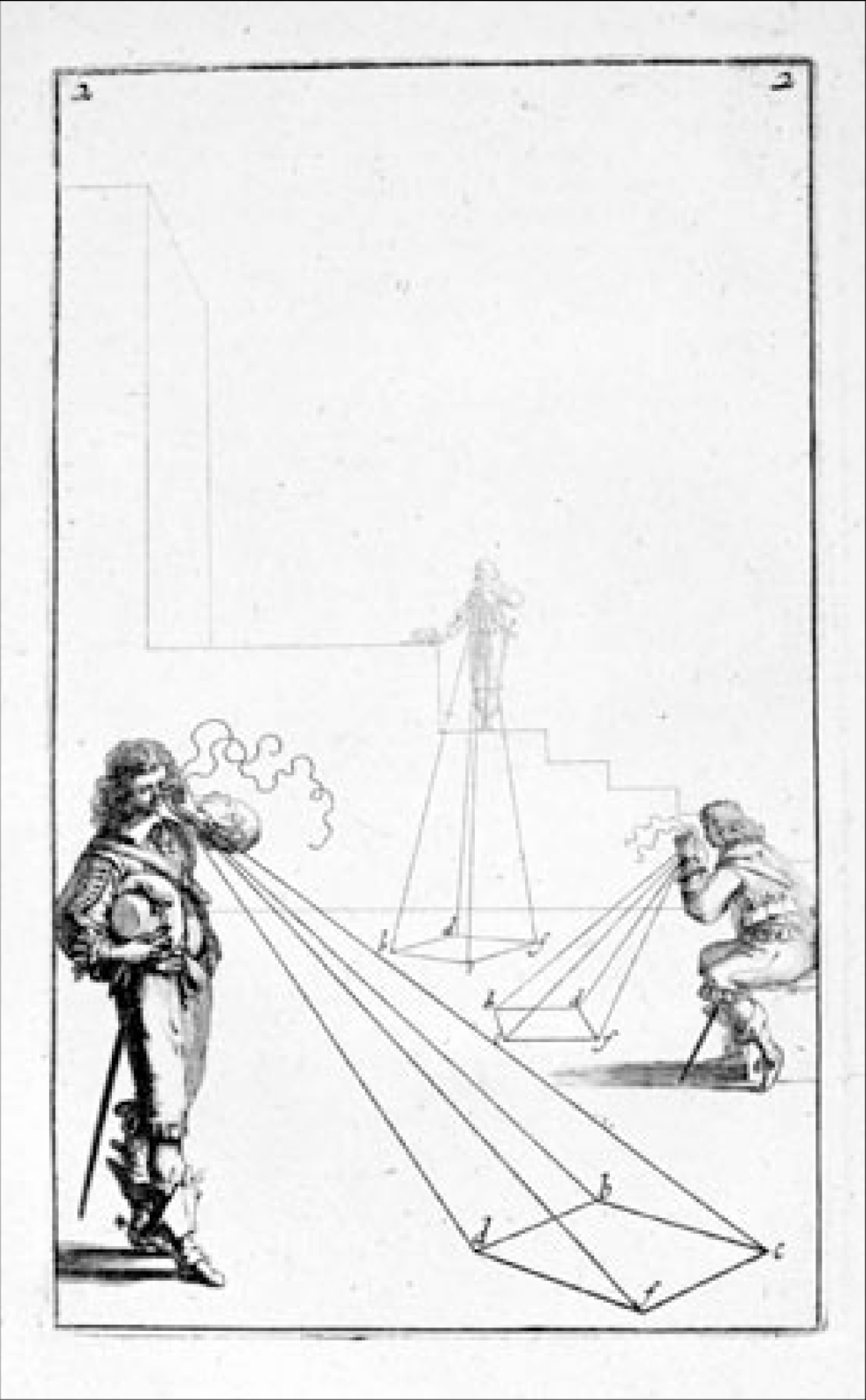
[fig 1] Abraham Bosse, illustration from Manière Universelle, 1648
By making lines of perspective visible, Ian Strange has in a way retrieved this idea from history’s pile of discarded concepts. The installation ‘Light Intersections II’ reveals the lines of perspective as they collide through a terrace house in the Sydney suburb of Surry Hills, reimagining it as an abstract geometric composition. Dozens of glowing sticks dive effortlessly through the shell of the house, tracing imagined paths through space, illuminating the invisible lines of construction. We see the simple artifice of this intervention – LED tubes propped up by scaffolding, bolts and cables – and yet it appears as something from the digital realm, as though we are looking at the city through the screen of 3D modelling software. The sticks of light are immaterial, lacking weight or substance, slicing improbably through the house’s heavy brick walls.
Renaissance perspective is not just a way of viewing the world, it is also a worldview, bound up in ideas of religion, mercantilism, imperialism and power. Perspective is used not just to accurately draw the world, but to claim it. [2] Wealthy landowners commission paintings of their estates, reinforcing authority and ownership. Explorers and cartographers trace coastlines as they sail by, the mere act of drawing constituting a claim to sovereignty. In this way, the world is ordered by those who hold the pen. Perspective places the individual at the centre, in the seat where only God once sat, where everything is revealed, and all lines of sight converge. The mistaken belief in lines of vision projecting from the eye was founded on this powerful feeling of being at the centre of all things.
But what happens when these lines of perspective don’t converge? When there is no clear vanishing point? In Strange’s house in Sydney different ordering principles are at work, something more chaotic. Viewed from the front the lines appear random, colliding at odds to one another, like a giant game of pick up sticks. The lights reveal graffiti and the missing panels of cast iron balustrade, giving the feeling of aggression. If these are lines of perspective, they don’t lead anywhere, but instead they disrupt and clash, dissolving any claims to authority. Viewed from the side, there is a more intentional logic at play. The glowing struts appear to be trained on a common destination, obeying the strict rules of projection. The spacing of the struts echoes the proportions of the building, creating a resonance between the Victorian parapet, and the bluestone foundations. A diagonal strike can be glimpsed through each of the five windows, creating a dialogue between these two seemingly incompatible systems of order: the compressive and the vectoral. In this way, Strange’s installation undermines the easy link between perspective and authority. By intersecting the building at odd angles, these lines of projection don’t seek to control and claim this building, but explode it. Its solidity is dissolved, at once drawing our attention to this object, while directing it somewhere else far off where these lines converge.
By casting the vanishing point out of scene, we are free to bring new eyes to this house. We can view it as an installation, as a piece of public art, as a performance, as a disruption to our routines, a distraction in lockdown. Most crucial of all is what it is not: an asset. For once it doesn’t matter who owns it, or what it’s worth. As the average price of a house in Sydney rushes past $1.3m, the dominant perspective today is that of the real estate website. The images of domain.com.au has replaced our urban imaginations, packaging up homes as assets to be traded, stripping them of their domestic role, no longer places to be lived in, but to be flipped. The booming market has overwhelmed all other forms of value – cultural, artistic, exploratory, propositional – so that the only thing we are left to be curious about is what it will sell for.
This is the transformative alchemy of Strange’s intervention. Through the simple addition of these lines of light, this unremarkable terrace house, once a product to be acquired, is transformed into something which resists. It asserts another future for the city, one guided by possibility and ideas, rather than mere speculation. In this way, Strange not only transforms the house, but he transforms us. He gives us new eyes, projecting invisible threads, to see the world not as it is, but as it could be.
–
Dr Rory Hyde is Associate Professor in Architecture, Curatorial Design and Practice at the University of Melbourne and Design Advocate for the Mayor of London. From 2013 to 2020 he was the Curator of Contemporary Architecture and Urbanism at the Victoria and Albert Museum.
Notes:
[1] Rocco Sinisgalli, Leon Battista Alberti: On Painting: A New Translation
and Critical Edition, Cambridge University Press, 2011, p.26.
[2] Sam Jacob, Disappear Here: On perspective and other kinds of space, RIBA exhibition catalogue, 2018.
Credits
LIGHT INTERSECTIONS II was commissioned by the City of Sydney through the 2021 Art and About public art program. It was produced in collaboration with OFFICE, Scoundrel Projects, with producers Jedda Andrews, Holly Winter, and Adrian Shaprio.
